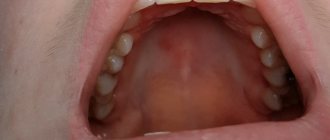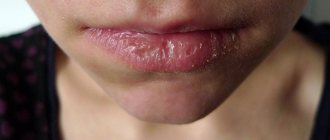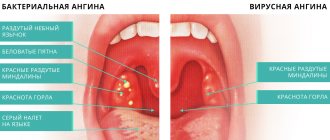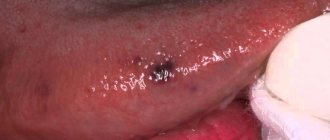Tonsillitis is an infectious disease in which inflammation of the tonsils (glands) occurs. This disease affects both adults and children aged 2 years and older. Tonsillitis in a child most often occurs between the ages of five and ten years, and inflammation can recur several times a year.
The acute form of the disease is nothing more than the well-known sore throat. A person who has suffered from a sore throat at least once, during which he experienced severe pain in the throat, will not confuse it with any other diagnosis. Sore throat is an insidious disease that can cause serious complications in related organs and even lead to disability. What effective measures should be taken in the treatment of inflammation of the tonsils to avoid complications? We will talk about this in detail in our article.
The main causes of rashes
The inside of the pharynx is protected by ciliated epithelium. The tissue is equipped with cilia that constantly move and push food into the esophagus. Quite often, rashes in the throat occur due to damage to the ciliated epithelium by bacterial or fungal infections. As medical practice shows, most often bacteria are the main cause of the appearance of red dots on the throat. Some parents, upon discovering red spots in the throat of their baby, begin to panic. But you should know that such a manifestation does not always indicate that a serious illness is developing that threatens life. There are several reasons that can trigger the appearance of red dots, namely:
- allergic reaction to food;
- acute respiratory disease;
- disturbances in the functioning of the body's protective function.
If the spots cover the soft palate and the back wall of the pharynx, this indicates that an infectious disease is developing. Quite often, this symptom appears in children due to mechanical damage to the tissue. Over time, the ciliated epithelium is restored, and the scars resolve.
Common diseases
Once harmful microorganisms enter the body, they begin to actively multiply and release waste products that can destroy tissue. When they enter the pharynx, they attach to the tissues of the ciliated epithelium - practically destroying it. For this reason, small hemorrhages may form that resemble red dots on the throat.
There are also common viral diseases that often occur in both children and adults. In frequent cases, they become the causes of a rash in the throat. So, with the development of herpetic sore throat, viral pemphigus, allergies, herpetic pharyngitis, spots appear in the larynx. You should know that only a qualified specialist, after a thorough examination of the patient, is able to make an accurate diagnosis. Based on the diagnostic results obtained, the doctor will prescribe effective therapy that will help get rid of the disease. Self-medication can be harmful and cause the development of serious health complications.
Scarlet fever - symptoms and treatment
Early complications
In the case of a severe course with a toxic form, a terrible complication develops - toxic shock .
Purulent-septic complications may occur: peritonsillar (next to the palatine tonsil) abscess, neck phlegmon, purulent otitis and mastoiditis (inflammation of the mastoid process of the temporal bone), sinusitis and sepsis. In these cases, immediate resuscitation and surgical actions are needed. But the most disabling complications are associated with autoimmune reactions when acute rheumatic fever . The full picture includes five symptoms: inflammation of the tissues of the heart, migratory polyarthritis, chorea, annular erythema and rheumatic nodules on the skin. It develops more often in children 7-15 years old, this is due to the epidemiology of scarlet fever and streptococcal infections. In adults, chronic forms are more often detected. According to the State Statistical Report in Russia in 2014, the prevalence of rheumatic fever is:
- 1.8 per 100 thousand children from 0 to 14 years - acute forms;
- 11.8 per 100 thousand children and 118.4 per 100 thousand of the total population are chronic forms [12].
Late complications
Late complications include diseases that are not directly related to the pathogen and are caused by impaired immune response: carditis, arthritis, chorea and glomerulonephritis.
Carditis occurs with inflammation of the heart valves, the mitral and aortic valves are most often affected, valvular insufficiency and regurgitation develop (backflow of blood through the valves). On examination, an organic systolic murmur is heard. Treatment with anti-inflammatory drugs does not always lead to improvement, and in some cases chronic heart disease develops. Against the background of blood volume overload, the symptoms of heart failure intensify. Then the patient requires surgical treatment with valve surgery.
Arthritis is an inflammation of mainly large joints, accompanied by pain, swelling, and stiffness in movement. It is characterized by damage to several joints, most often the knees and ankles, and migratory inflammation. Good response to anti-inflammatory therapy. In case of inadequate treatment and genetic predisposition, a chronic course of arthritis develops with repeated attacks and joint deformation.
Chorea sometimes occurs after 6 months. A person develops gait disturbances, involuntary, uncontrolled movements of the arms, legs, body, and facial expressions, which are usually excessively expressed. From the outside, the condition resembles dancing, hence the name. On examination, muscle tone is reduced, reflexes are animated, sweating is pronounced, temperature is unstable, and excessive emotionality is present. Long-term antibiotics, anti-inflammatory and anticonvulsant drugs are effective in treatment.
PANDAS syndrome stands for Pediatric Neuropsychiatric Autoimmune Disorder. The complication was discovered relatively recently, at the end of the 20th century. The characteristic symptoms of this disorder are obsessive-convulsive seizures. The patient develops obsessive thoughts and movements, motor or vocal tics, emotionality and memory impairment may appear. With antibacterial and immune therapy, improvement occurs, but with repeated streptococcal infection or a stressful situation, the symptoms return.
Glomerulonephritis is an autoimmune kidney disease. Characteristic symptoms are edema, dysuria (impaired urination), hematuria (blood in the urine), increased blood pressure, and renal failure. Assessing a general urinalysis helps in diagnosis, especially with mild symptoms. In therapy, water and salt are limited, antibiotics, diuretics, antihypertensive, anti-inflammatory drugs are used, and in case of renal failure - dialysis [12][13].
How to determine the presence of herpetic sore throat
Herpangina is an infectious disease that occurs due to the introduction of the Coxsackie virus into the body. Already at the initial stage of development of the disease, the patient experiences severe discomfort and disturbances appear when swallowing food due to the development of a strong inflammatory process.
Vesicles in the throat are a hallmark of the disease. Reddish spots may develop into ulcers. Among the main signs of herpetic sore throat are:
- sore throat, red spots in the mouth;
- significant increase in body temperature;
- sore throat and sore throat;
- discomfort when swallowing food;
- runny nose;
- severe weakness.
As the disease progresses, the size of the rash increases in diameter.
Symptoms of the disease in children
The first symptoms in children suffering from acute tonsillitis appear already on the first to third days after infection, among them:
- high body temperature (with fever, the temperature may rise to 40°C);
- severe pain in the throat, it is very difficult and painful for the child to swallow;
- the tonsils increase in size and turn red; pustules may be noticeable on them;
- headache;
- sick children lose their appetite;
- weakness, lethargy;
- enlarged lymph nodes;
- gastrointestinal tract disorders are possible;
- bad breath.
In children with chronic tonsillitis, the symptoms are not as pronounced. The body temperature remains at the subfebrile level for a long time (37-37.5°C). The tonsils become loose - a sign that they have lost their protective function.
How to determine the presence of viral pemphigus
Viral pemphigus is an infectious disease. Red dots in the throat of children and adults with this disease appear due to the action of the Coxsackie virus and enteroviruses. As the disease develops, blisters form that are filled with a liquid substance. The disease progresses smoothly. At the very beginning, the patient feels slight weakness, after which his body temperature rises.
The appearance of a red rash is one of the main signs of the disease. Viral pemphigus is a serious disease that does not threaten the child’s life. If treatment is carried out correctly and in a timely manner, you can get rid of the signs of the disease in the shortest possible time.
Symptoms of an allergic reaction
Quite often, red spots in the throat occur due to the development of an allergic reaction. Most often, red dots appear in the child’s throat, but the temperature is not elevated. Allergies occur in children under 7 years of age due to insufficiently developed immunity. When such a reaction occurs, there is no pain, soreness or itching in the throat. The patient also has no weakness or malaise. Red spots in the throat are the only sign that indicates a problem with the body. The following factors most often provoke the appearance of red dots in the throat:
- toothpastes;
- oranges and lemons;
- products that contain cocoa chemicals.
During the development of an allergic reaction, an unpleasant sensation rarely occurs, but there is still a need to limit the child from exposure to the allergen, otherwise hypoxia may occur. With the help of Claritin, Suprastin, Zyrtec, you can relieve allergies.
Why can stomatitis affect the tonsils?
Tonsils (tonsils) are collections of lymphoepithelial tissue that are located in the oral cavity and nasopharynx. When pathogenic microbes enter the body through airborne droplets, the tonsils protect it and create local immunity, so stomatitis on the tonsils is rare and is mainly a consequence of complications after infections.
In children, stomatitis on the tonsils appears in the following cases:
- the rules of oral hygiene are not observed, that is, the baby puts dirty toys, hands, food that has fallen on the floor into his mouth;
- decreased immunity;
- recently suffered a viral infection;
- there are gastrointestinal diseases;
- the baby suffers from allergies;
- helminthic infestations are present;
- dental caries has not been cured.
Herpetic pharyngitis
During the development of herpetic pharyngitis, severe inflammation occurs in the throat due to the introduction of the herpes simplex virus into the body. When pathology occurs, painful vesicles form in the throat, which spread along the back wall of the pharynx. If timely and comprehensive treatment is not carried out, serious health complications may arise. Due to the appearance of a cold, herpetic pharyngitis often develops. Among the main signs of the disease are:
- red throat with white spots;
- heat;
- signs of intoxication;
- painful sensations when swallowing food;
- severe inflammation in the throat, which is accompanied by a feeling of itching and burning.
Most often, the disease occurs in children due to an insufficiently developed protective function of the body. If therapy is not carried out in time, the vesicles will begin to merge with each other, forming large bubbles. Under such conditions, severe pain and discomfort occur.
Therapy is carried out using antiviral drugs. To do this, use an ointment, gel, solution or aerosol that promotes wound healing.
Complications
It may seem that acute tonsillitis is a completely harmless disease. “Sore throat, fever - what’s wrong with that? A common manifestation of infection,” you say. But let us remember the nature of the disease. Its causative agent, streptococcus, can cause serious consequences.
Complications after tonsillitis can be divided into local (they are localized and noticeable in a certain area) and general (when changes affect the whole body).
Local ones include:
- paratonsillar and parapharyngeal abscess;
- mediastinitis (when a purulent infection descends into the heart sac);
- bleeding from the tonsils, provided that there were ulcers on their surface;
- otitis and eustacheitis (ENT organs are directly connected to each other, so an infection from the throat can easily migrate to the middle ear cavity, the auditory tube and cause an inflammatory process there);
- swelling of the larynx (with this condition, asphyxia develops. This condition is very dangerous, even fatal. A characteristic sign is a bluish tint of the skin against the background of severe suffocation);
- phlegmon and abscesses (purulent inflammation).
Common complications include diseases of the heart, kidneys, joints (rheumatism), tonsil intoxication and sepsis. In order to avoid dangerous consequences for the child’s body, it is very important to promptly begin the fight against tonsillitis under the supervision of a qualified otolaryngologist.
Friends! Timely and correct treatment will ensure you a speedy recovery!
Make an appointment right now!
Call us by phone or use the feedback form
Sign up
Rare diseases
Sometimes red spots in the throat appear due to the development of a rare disease. Under these conditions, it is important to seek help from a qualified professional.
Thus, during the development of infectious mononucleosis, red spots may appear in the throat. Already at the initial stage of development of the disease, symptoms arise that cause severe discomfort to the patient, namely:
- the temperature rises,
- throat red with red dots;
- lymph nodes, liver and spleen are affected.
And when Kaposi's sarcoma occurs, malignant neoplasms form in the throat. This disease is more common in those people who have serious problems in the body’s protective function and in carriers of the herpes virus type 8.
Pathogenesis
Behind the external manifestations of the disease, very deep and significant problems are hidden. A child can develop stomatitis in the throat under the influence of even the slightest provoking factor. This is due to the fact that the mucous membrane lining the oral cavity is a favorable environment for the activity of pathogenic microorganisms, especially if it is damaged.
The causative agent of stomatitis is transmitted through alimentary or droplet-aerogenic routes. If at this time the child’s defenses are weakened and the oral mucosa has a low degree of resistance to infectious agents, the process of active life of the pathogen begins. In addition, under these conditions, pathogenic properties of microbes that are normally part of the microflora often manifest themselves.
Treatment process
Only a doctor can prescribe medications that can effectively eliminate the problem. In order to get rid of the disease as soon as possible, it is important to undergo a full examination. The therapist or pediatrician will prescribe a suitable method of therapy.
First of all, the specialist assesses the nature of the rash and its location. The patient should receive advice from an infectious disease specialist, oncologist and otolaryngologist. In frequent cases, red rashes appear due to a viral disease, which must be treated with antiviral and immunostimulating medicine.
Effective drugs
Treatment of a red throat with white dots in a child is carried out with the help of Acyclovir, Valacyclovir, Alfaron, Cycloferon.
Thanks to rinsing with Hexoral and Orasept, you can get rid of painful sensations and reduce the number of tumors in the throat. It should be noted that such drugs are most often prescribed to children, since these drugs are safe and do not harm the general health of children.
The duration of treatment is determined by a specialist depending on the severity of the disease. Many medications have contraindications, so you should not risk your health.
How to cure tonsillitis in a child
Treatment methods for sore throat depend on the nature of the pathogen: for bacterial sore throat, the doctor will prescribe effective antibiotics (the drugs Augmentin, Amoxiclav, Erythromycin are more often prescribed), for sore throats of a viral and fungal nature - anti-inflammatory and antifungal drugs, respectively. The name of the drug, its dosage and the duration of its use can only be determined by an ENT doctor. Excessive parental independence can interfere with the effective treatment of acute or chronic tonsillitis.
If a child's temperature rises above 38°C, an antipyretic based on ibuprofen or paracetamol should be given. Due to blood thinning and the risk of bleeding, aspirin is strictly contraindicated in children.
It is necessary to adhere to strict bed rest and a gentle diet. Eating and drinking should not cause additional strain on the throat. It’s better to make do with warm soups, broths and purees for the first time. Oral antiseptic sprays, special lozenges and tablets (for example, Faringosept) are perfect for relieving a sore throat.
Note to the patient
If a red rash appears in the throat, it is important to seek help from a specialist, since this phenomenon is not a normal physiological feature of the body. In frequent cases, a red throat and white dots on the tonsils indicate that an infectious disease is developing.
To prevent the development of serious complications, it is necessary to undergo a thorough medical examination by qualified specialists. As medical practice shows, with timely treatment you can get rid of the disease within a week. To prevent the development of the disease, it is important to promptly treat other pathological conditions, take measures to strengthen the immune system, and regularly visit a doctor. To strengthen the immune system, doctors advise:
- eat properly and balanced;
- take vitamin complexes;
- to live an active lifestyle;
- avoid overwork and stress;
- walk more in the fresh air;
- do physical education.
At home, it is not possible to identify the disease that caused the appearance of red spots on the throat. Only after a thorough medical diagnosis is the doctor able to make a diagnosis and prescribe effective therapy. The duration of the course of treatment and dosage are determined strictly by the doctor, depending on the severity of the disease and the physiological characteristics of the patient’s body. Traditional recipes should be used exclusively according to the recommendations of a specialist.
Diagnosis of the disease
A doctor can make a diagnosis of stomatitis after examining the patient. He pays attention to special signs:
- general condition of the oral cavity;
- forms of ulcers and boundaries of erosions;
- presence of white plaque;
- presence of complaints (headache, fever, weakness).
In addition to a general examination, for an accurate diagnosis and correct treatment, the results of certain tests may be required.
After the examination, the specialist will prescribe tests to clarify the picture of the disease:
- general blood analysis;
- culture of saliva to determine the causative agent of the disease;
- smear of the oral mucosa (histology and cytology).
In severe cases of the disease or transition to a chronic form, the following are additionally prescribed:
- determination of blood sugar levels;
- blood chemistry;
- immunofermentogram (determines the level of protective reactions).








